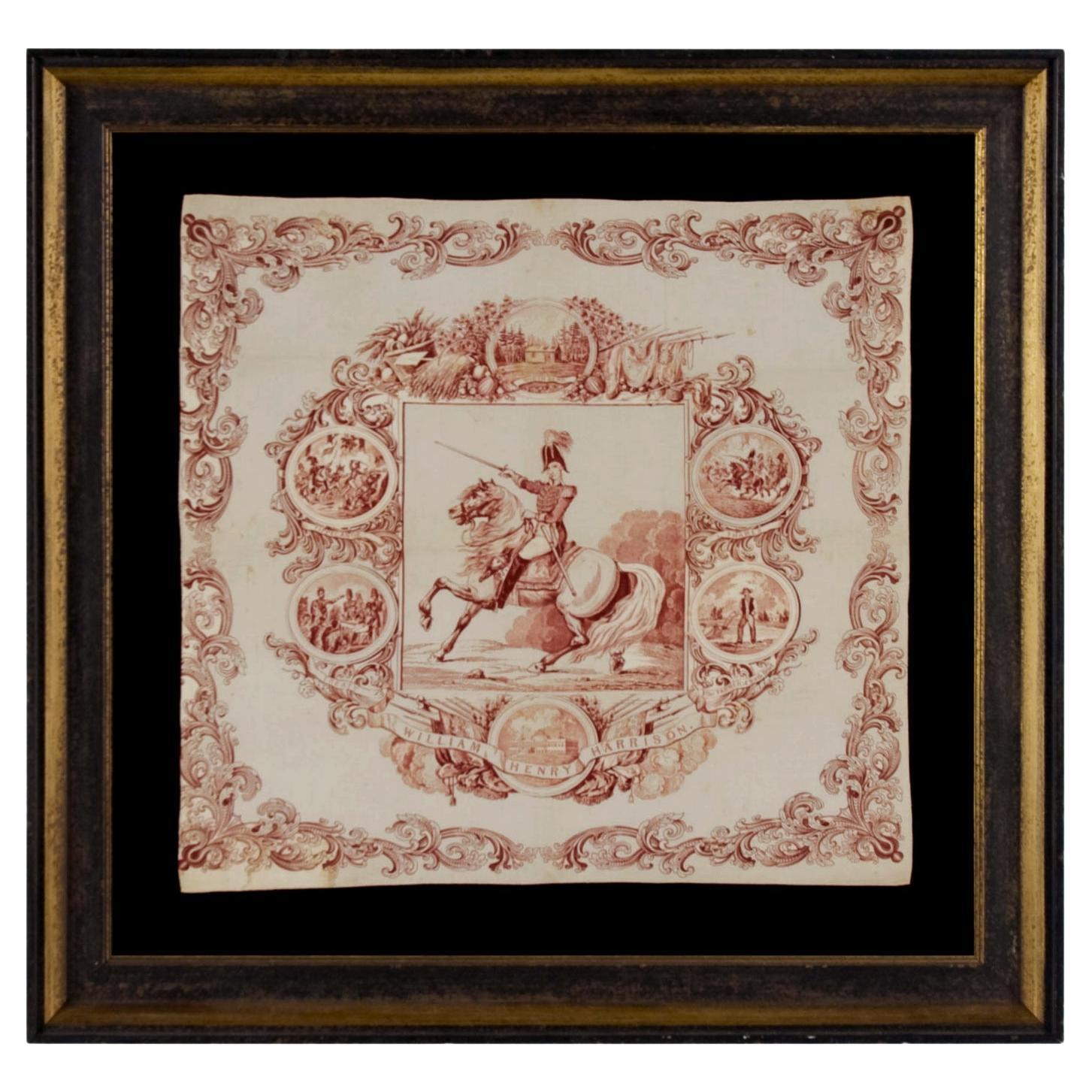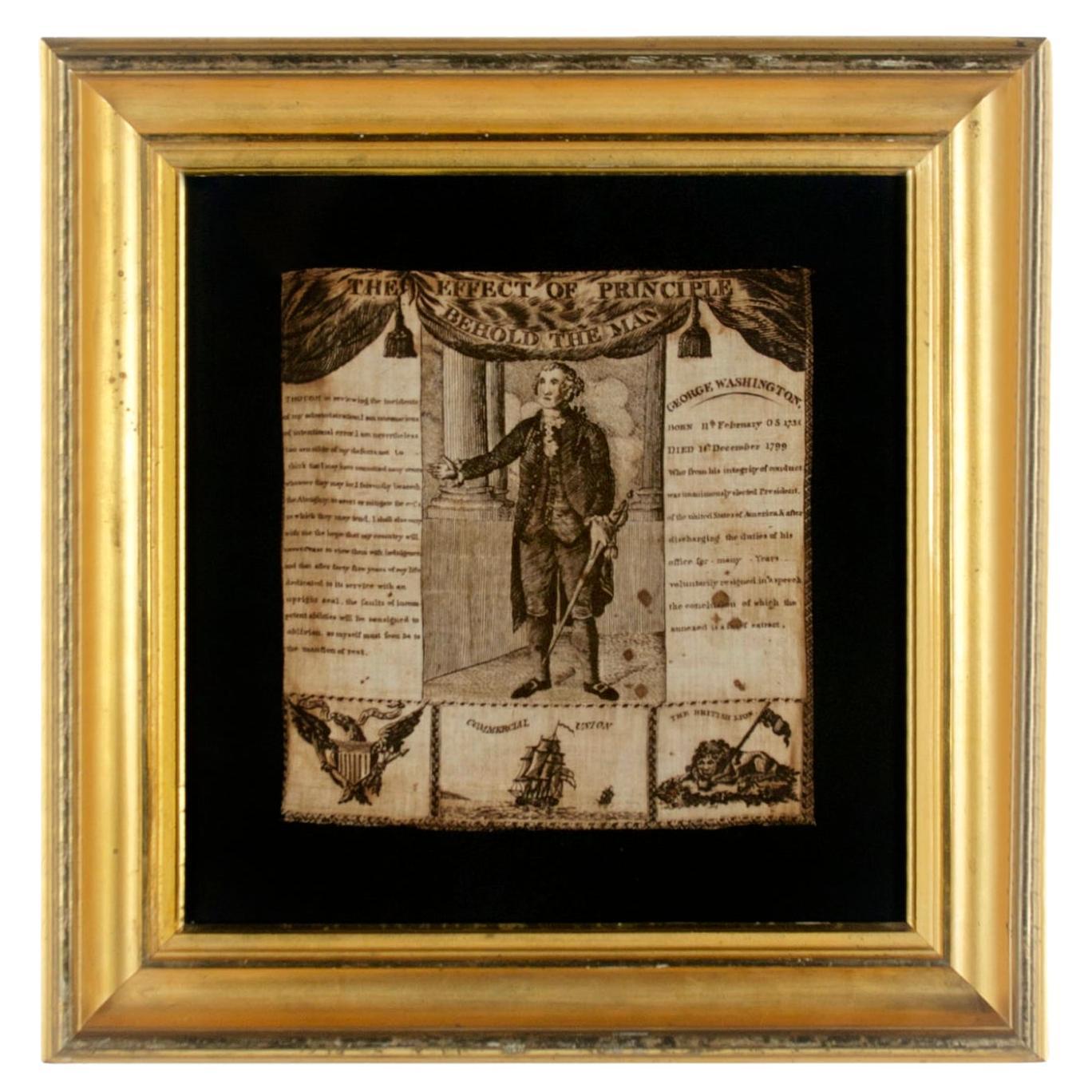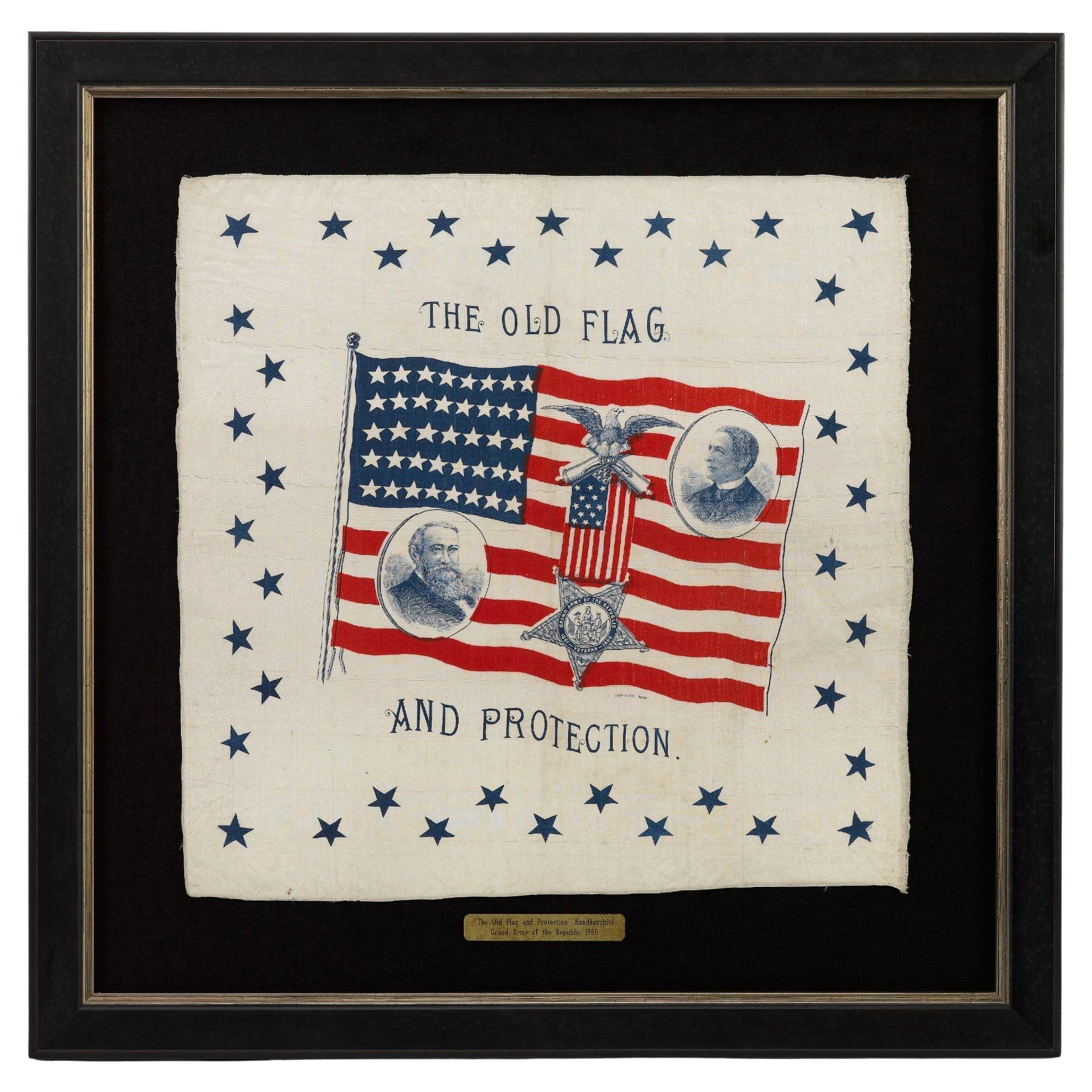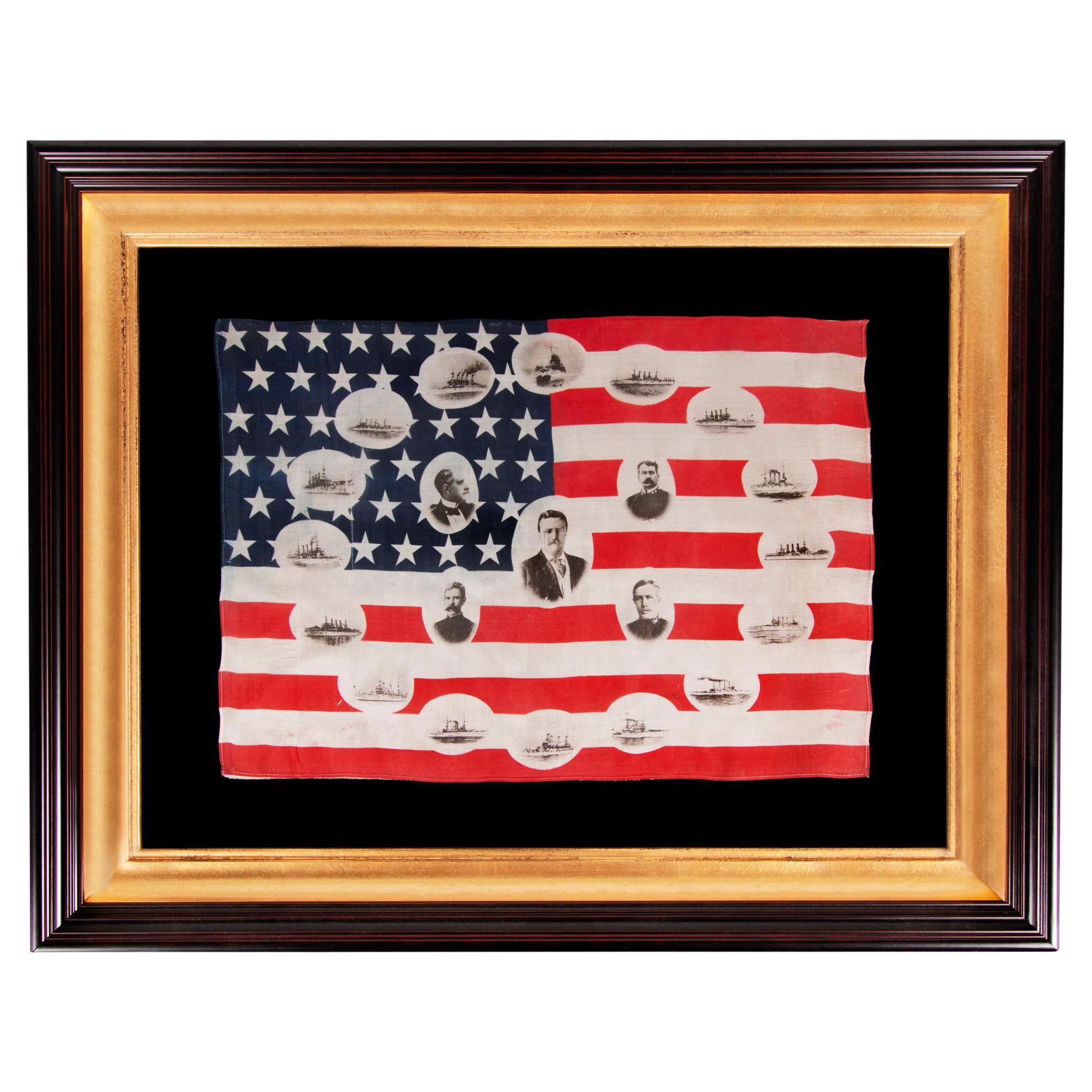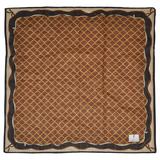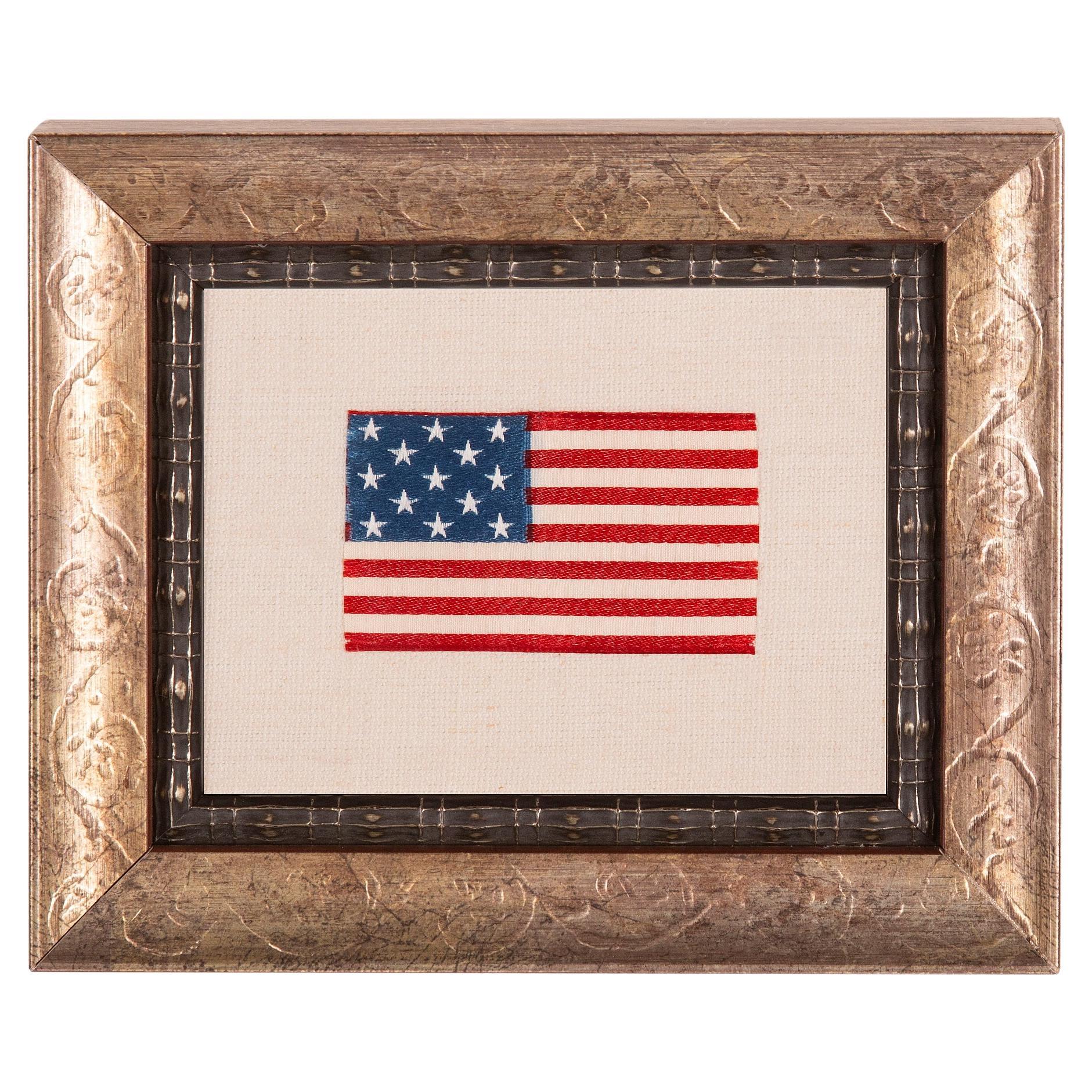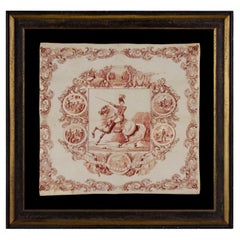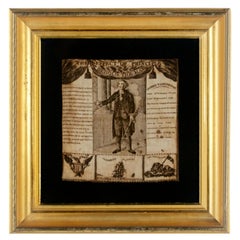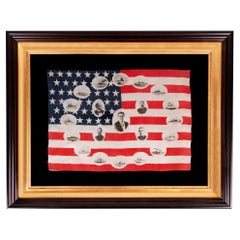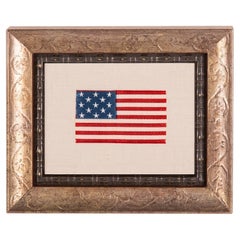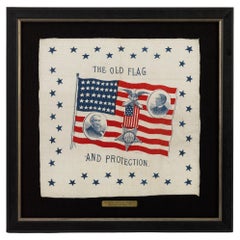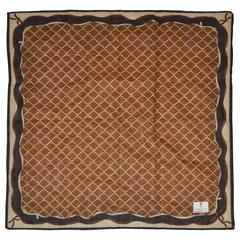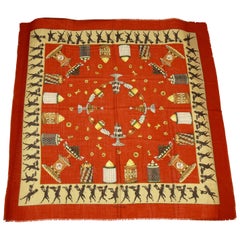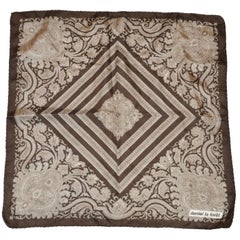Items Similar to Teddy Roosevelt Silk Kerchief Made for His 1912 Presidential Run
Want more images or videos?
Request additional images or videos from the seller
1 of 5
Teddy Roosevelt Silk Kerchief Made for His 1912 Presidential Run
Price Upon Request
Price Upon Request
Price Upon Request
Price Upon Request
Price Upon Request
Price Upon Request
Price Upon Request
Price Upon Request
Price Upon Request
Price Upon Request
About the Item
SILK CAMPAIGN KERCHIEF FEATURING A PROMINENT BULL MOOSE, MADE FOR THE 1912 PRESIDENTIAL RUN OF TEDDY ROOSEVELT, WHEN HE RAN ON THE NATIONAL PROGRESSIVE PARTY TICKET
Printed silk kerchief, made for the 1912 presidential campaign of Theodore Roosevelt when he ran on the Progressive Party ticket. In this scarce example, the typical geometric design of a western bandanna is made personal to Roosevelt by the inclusion of a large center medallion with the image of a bull moose. This is flanked by smaller medallions in each corner containing both bull moose and illustrations of his famous Rough Riders slouch hat.
Roosevelt nicknamed his the “Bull Moose Party” in comic yet serious notation to his bull-headed nature. This manner of choosing a mascot fell in line with the Republican and Democrat selections of the Elephant and Donkey. The presence of such a large moose makes this unlike other examples, none of which feature the mascot as prominently and many of which don’t feature it at all. Before 1912, no party mascots were illustrated on campaign textiles, so this is among the very first to do so.
Roosevelt had declined to run in 1908, following a long-standing tradition that Presidents were expected to leave office after two terms. He appointed his friend, William Howard Taft, as his successor, who won and served the next four years. During his forthcoming administration, a rift grew between Taft and Roosevelt, who each became leaders of the Republican Party's two ever-spreading wings. The progressives opposed the court system, favored restrictions on women's employment, favored conservation, were more favorable toward labor unions, and opposed tariffs. The conservatives were pro-business and insisted on judicial supremacy. Taft became identified with the conservative wing, while Roosevelt was the leader of the progressive wing.
By 1910 the split was deep. Roosevelt ran for nomination on the Republican ticket but lost to Taft, so in true T.R. fashion, he waved off defeat and set out on his own. Despite rather serious opposition from his many Republican friends, he jumped into the ring with no apparent reason to believe that he might actually lose. In the forthcoming election he did beat Taft, gaining 88 electoral votes versus Taft’s almost non-existent count of 8. In doing so he became the only man in history to place second on an independent ticket. He was slaughtered by Wilson, however, who received 435 votes in the Electoral College and served two terms in the nation’s highest office. A disgruntled Roosevelt retreated to what he loved best, risk and adventure. He traveled to the Amazon jungle, where he ran an uncharted river and nearly perished.
An example of the kerchief resides in the collection of the Smithsonian and is documented in “Threads of History” by Collins, Smithsonian Press, 1979 (item 939, pg. 373). Collins served as the Smithsonian's curator of political history and his landmark text is considered the definitive reference on political flag and textile collecting.
Mounting: The kerchief has been hand-stitched to 100% cotton twill, black in color, that has been was washed to reduce excess dye. An acid-free agent was added to the wash to further set the dye and the fabric was heat-treated for the same purpose. The mount was then placed in a very high quality gilded French molding with a distinctive early American profile, to which a black rippled liner with gold highlights was added. The glazing is U.V. protective Plexiglas.
Condition: Excellent.
- Dimensions:Height: 20 in (50.8 cm)Width: 23.5 in (59.69 cm)Depth: 2 in (5.08 cm)
- Materials and Techniques:
- Place of Origin:
- Period:1910-1919
- Date of Manufacture:1912
- Condition:See Item Description.
- Seller Location:York County, PA
- Reference Number:Seller: ker-2481stDibs: LU849744942322
About the Seller
5.0
Recognized Seller
These prestigious sellers are industry leaders and represent the highest echelon for item quality and design.
Established in 1991
1stDibs seller since 2008
70 sales on 1stDibs
Typical response time: 1 to 2 days
- ShippingRetrieving quote...Shipping from: York County, PA
- Return Policy
Authenticity Guarantee
In the unlikely event there’s an issue with an item’s authenticity, contact us within 1 year for a full refund. DetailsMoney-Back Guarantee
If your item is not as described, is damaged in transit, or does not arrive, contact us within 7 days for a full refund. Details24-Hour Cancellation
You have a 24-hour grace period in which to reconsider your purchase, with no questions asked.Vetted Professional Sellers
Our world-class sellers must adhere to strict standards for service and quality, maintaining the integrity of our listings.Price-Match Guarantee
If you find that a seller listed the same item for a lower price elsewhere, we’ll match it.Trusted Global Delivery
Our best-in-class carrier network provides specialized shipping options worldwide, including custom delivery.More From This Seller
View All1840 Campaign Kerchief of William Henry Harrison on Horseback
Located in York County, PA
1840 campaign kerchief featuring an image of William Henry Harrison on horseback in military garb, one of the first known campaign textiles in e...
Category
Antique Mid-19th Century American Political and Patriotic Memorabilia
Materials
Cotton
Price Upon Request
Printed Linen Kerchief of George Washington, ca 1806, Germantown, PA
Located in York County, PA
Extraordinarily early (1806) printed linen kerchief glorifying George Washington, Germantown print works, Germantown, Pennsylvania
Printed in sepia ink on coarse, white linen, this patriotic kerchief shows a standing portrait of George Washington, above which is a swag valance and the words “The Effect of Principle, Behold the Man”. The portrait is based on a mezzotint after Gilbert Stuart’s very famous painting of Washington in his later years. Stuart painted it in oil on canvas for a wealthy merchant by the name of William Constable, who commissioned the work for Alexander Hamilton.
The kerchief is interesting because it is both American-made and documented. This is exceptionally unusual for any printed textile of the 19th century or prior and the earlier the time period the more unlikely an object is to be identified. This kerchief and a companion piece entitled “The Love of Truth Mark the Boy” (also glorifying Washington through the fabled story of the cherry tree), were made ca 1806 by Germantown Print Works in Germantown, Pennsylvania.
To the left of Washington's image is a portion of his infamous farewell address to his troops at the end of the Revolutionary War. To the right is a short excerpt from his eulogy. Below these are three images. In the center is a square-rigged tall ship with “Commercial Union” above it, flanked by the American eagle on the left and the British lion...
Category
Antique Early 19th Century American Political and Patriotic Memorabilia
Materials
Linen
Teddy Roosevelt and His Great White Fleet American Flag, circa 1907-1909
Located in York County, PA
Rare & Beautiful American Parade Flag With Images Of Teddy Roosevelt And His Great White Fleet, 1907-1909, Ex-richard Pierce Collection:
46 star parade ...
Category
Antique Early 1900s American Political and Patriotic Memorabilia
Materials
Silk
Price Upon Request
13 Star Woven Silk Ribbon, ca 1876-1910
Located in York County, PA
13 STAR RIBBON, WOVEN SILK, circa 1876-1910
13 star antique American flag ribbon, made of woven silk, of the type encountered in military, political, and fraternal badges and ribbon...
Category
Antique 1870s American Political and Patriotic Memorabilia
Materials
Silk
13 Star Commission Pennant, 6 Foot in Length, ca 1892-1910
Located in York County, PA
6-FOOT SHIP’S COMMISSION PENNANT WITH A 5.5” HOIST AND 13 STARS IN 2 STAGGERED ROWS, LIKELY PRODUCED FOR A PRIVATE VESSEL, circa 1892-1910
Commission pennants are the distinguishing...
Category
Antique 1890s American Political and Patriotic Memorabilia
Materials
Wool
Eisenhower's 1952 Portrait Style Presidential Campaign Kerchief
Located in York County, PA
PORTRAIT STYLE KERCHIEF FROM THE 1952 PRESIDENTIAL CAMPAIGN OF REPUBLICAN IKE EISENHOWER, FORMER SUPREME COMMANDER OF ALLIED FORCES IN EUROPE DURING WWII (NATO)
Printed cotton kerch...
Category
Vintage 1950s American Political and Patriotic Memorabilia
Materials
Cotton
You May Also Like
"The Old Flag and Protection" Benjamin Harrison Campaign Handkerchief, 1888
Located in Colorado Springs, CO
Presented is an original Benjamin Harrison campaign handkerchief, from the 1888 presidential election. Printed on white silk, this design features a waving 39-star American flag and ...
Category
Antique 1880s American Political and Patriotic Memorabilia
Materials
Silk
Roberta di Camerino Signature Cotton Men's Handkerchief
By Roberta Di Camerino
Located in New York, NY
Roberta di Camerino signature 100% cotton men's handkerchief is finished with hand-rolled edges and measures 18 1/2" x 18 1/2" of Swiss cotton.
Category
1970s Italian Handkerchiefs
Karl Lagerfeld Vintage Delicacies Print Wool and Silk Shawl
By Karl Lagerfeld
Located in Nice, FR
KAR LAGERFELD vintage rare shawl depicting delicacies and waiters wearing a livery.
- Colors: Saffron background / Multicolored motif.
- Fringed borders.
- Composition label reads :...
Category
20th Century French Scarves
$472 Sale Price
20% Off
Daniel La Foret Detailed Coco Brown & Ivory Palsey Silk Handkerchief
Located in New York, NY
Daniel La Foret wonderfully detailed coco-brown & ivory palsey silk handkerchief accented with hand-rolled edges, measures 18 1/2 inches by 18 1...
Category
1980s Italian Handkerchiefs
Exceptional Hermès Vintage Silk Scarf Les Amours Hugo Grygkar 1947 Rare
By Hermès
Located in Corcoué Sur Logne, Loire-Atlantique
Absolutely Gorgeous Authentic Hermès Scarf
Called "Les Amours"
This scarf has been designed by Hugo Grygkar in 1947
Super Rare Scarf. Collectible ! No reissue
Rated 1A in the Hermès Scarves Book...
Category
1940s French Scarves
Ashear Beige Border with Tricolor Palsey Center Men's Silk Handkerchief
By Ashear
Located in New York, NY
Ashear beige border with tricolor palsey center men's silk handkerchief measures 19 1/2" x 19 1/2" and finished with hand-rolled edges. Made in Italy.
Category
